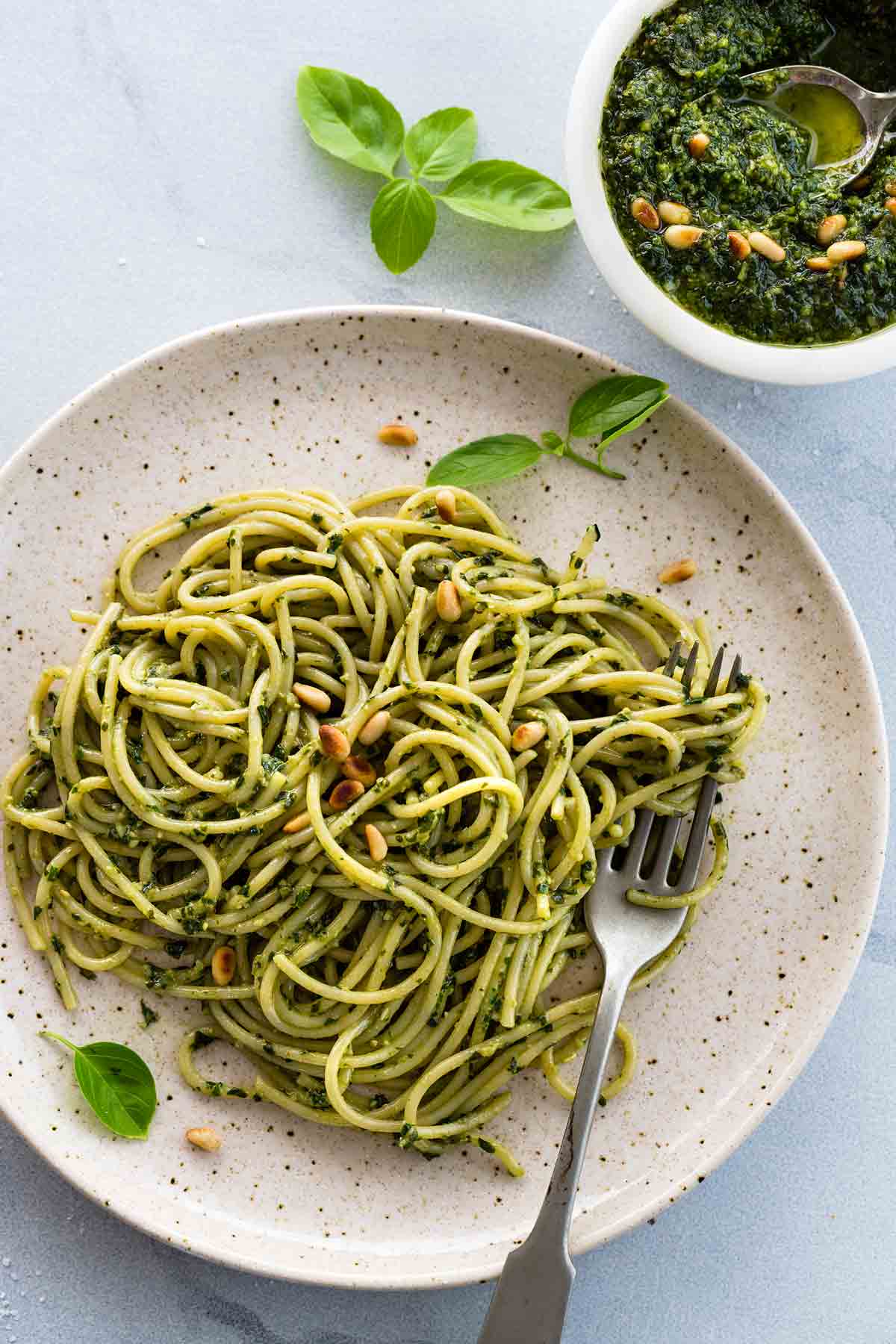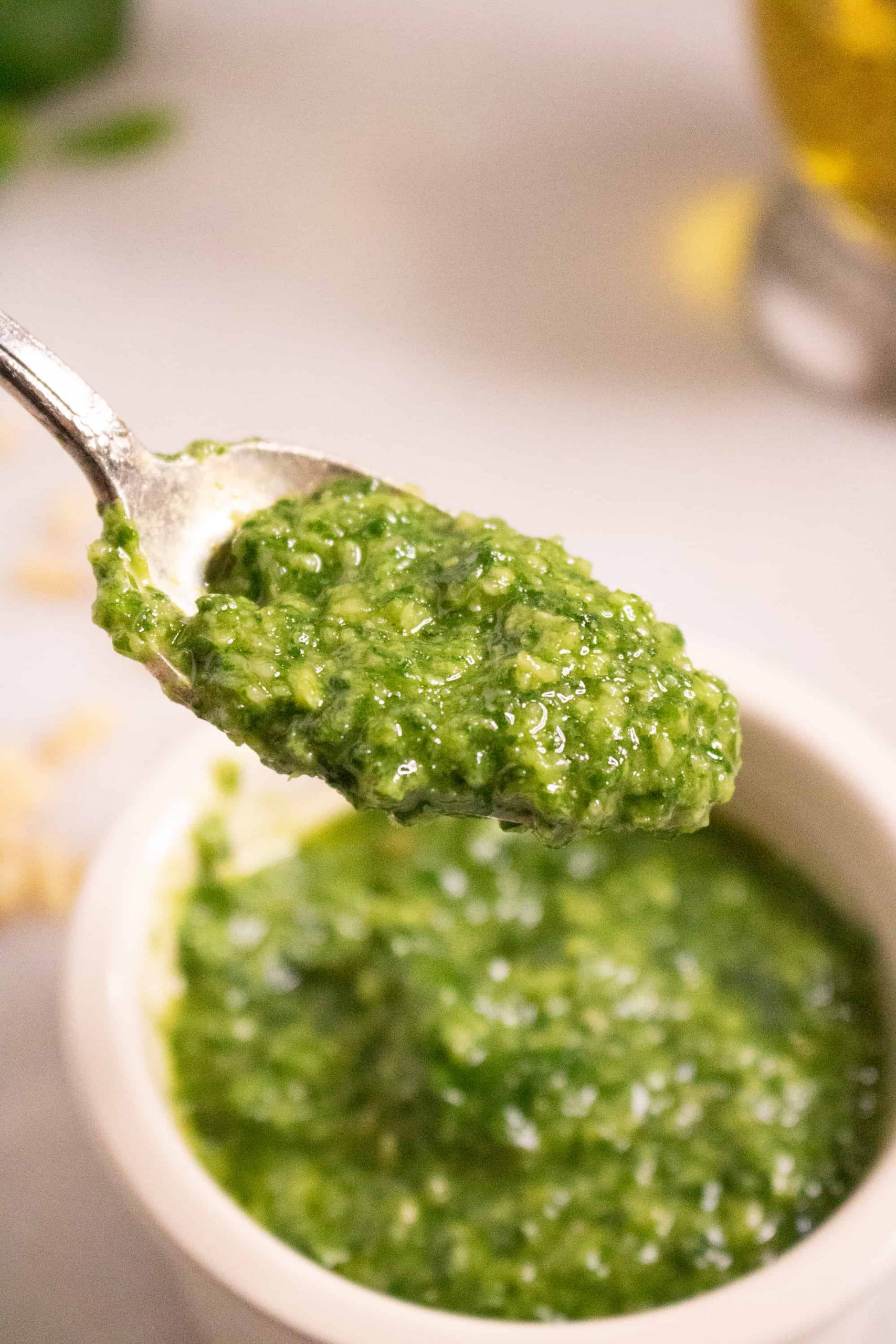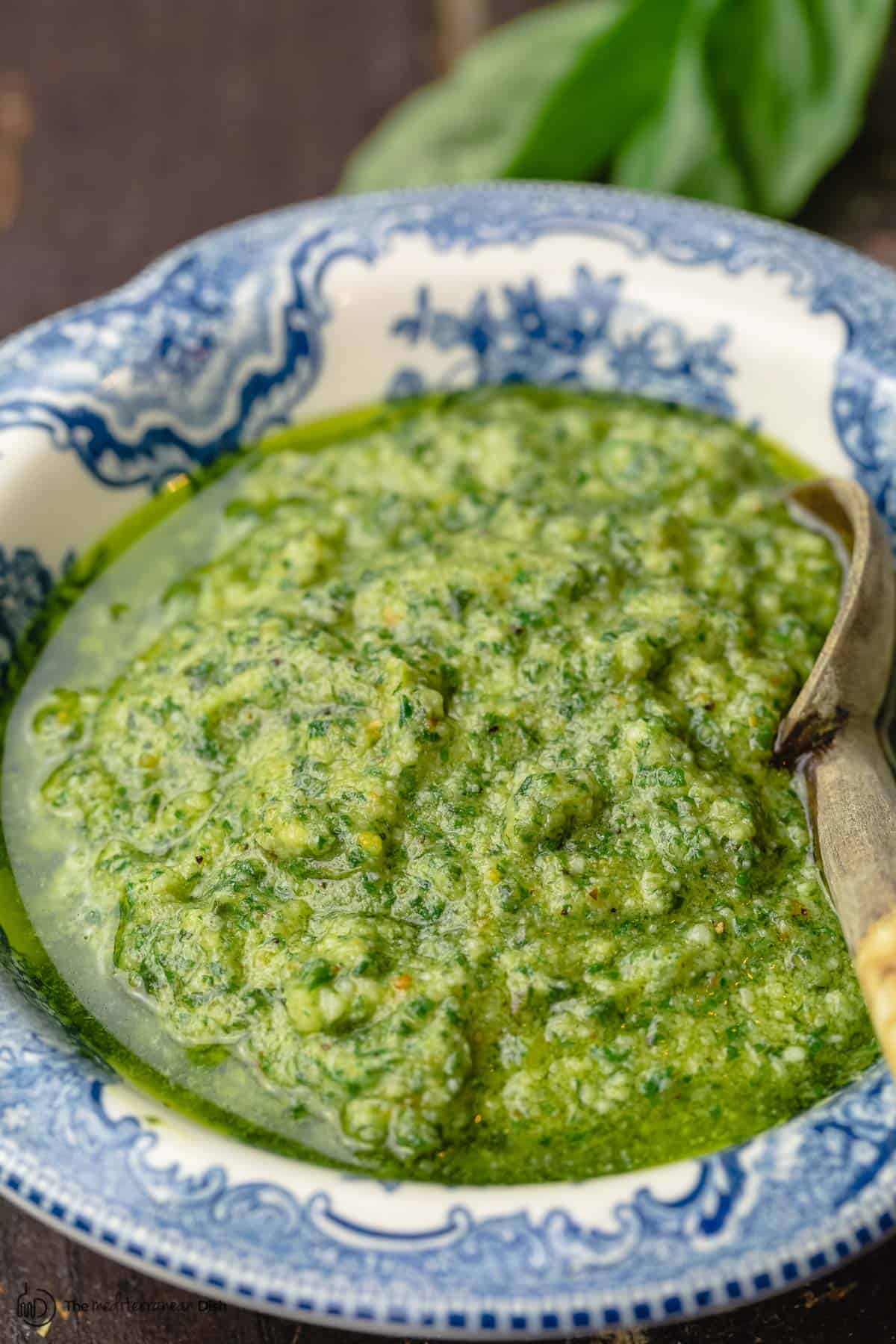How To Make Pesto Pasta With Pesto Sauce
Here is how you make the best pesto pasta, perfectly coated in sauce for maximum flavor and tossed with juicy, quick roasted tomatoes and fresh baby mozzarella. Keep it vegetarian or add in some shrimp, grilled lemon chicken or this quick Italian baked chicken.
Tips & make-ahead ideas included.
Reading: how to make pesto pasta with pesto sauce
There has been quite a bit of roasted tomatoes and homemade basil pesto coming out of my kitchen lately. And Ive been having so much fun finding different ways to use them up!
Earlier last week, I shared my 20-minute creamy pesto chicken. Many of you made it, doubling the sauce to toss in some pasta. Great idea!
But for days youre feeling straight up vegetarian pesto pasta-no cream and no chicken needed- todays recipe is for you!
Other Ways To Use Pesto From A Jar
You can use this herby, garlic-y puréed sauce to perk up just about anything.
- Use it on a pizza base. Substitute tomato marinara sauce for green or red pesto and add your toppings as usual.
- Add in salad dressings.
- Toast topper. Add a dollop on top of your egg or mushrooms on toast for a hit of strong flavor.
- Perk up your meat. Pesto packs a punch of flavor so you can add it to beef stew, roast beef, or chicken when the other flavors in the dish are lacking.
What Is Pesto Made Of
Pesto was historically made from ingredients that were crushed or pounded with a mortar and pestle. This method dates back to Roman times when Genoans would crush together walnuts with some herbs and garlic.
Although you can still make pesto the traditional way, its much, much quicker to whip it all together in a blender or food processor. The most popular way to make pesto is the way I have it listed here: using basil, garlic, olive oil, pine nuts, and a hard cheese like parmesan.
Read Also: Texas Pete Buffalo Wing Sauce Recipe
How To Store Pesto Sauce For Later
- Store it in the fridge, in a glass jar fitted with a tight lid for up to a week.
- Make sure you add some extra virgin olive oil to the surface.
- Make sure to cover the surface with plastic wrap before closing the lid.
- The green pesto will turn an even darker green color with time, but it will still be good.
- Freeze it in silicone ice cube trays for later use. We like to make large batches of pesto in the summer when basil is in season, freeze it and use it in the winter to add to soups, pasta, and pizza. We like the silicone trays because it is very easy to remove just one cube of pesto as needed. It lasts in the freezer for up to a year. Make sure the silicone ice cube trays are covered with a freezer bag or with aluminum foil and plastic wrap.
Ideas For Customizing Pesto

- If you dont have basil, you can substitute spinach, kale, arugula, parsley, cilantro, mint, tarragon, or even sage. You can also go a little crazy and combine some of the herbs to make your own new favorite flavor creation.
- Make pesto a bit on the spicy side by adding a pinch or two of red pepper flakes before blending.
- Pine nuts can be pricy and sometimes hard to find. Other nuts I like to use include cashews, walnuts, hazelnuts, pecans, sunflower seeds, and even pistachios.
- Skip the lemon juice if youd like a more classically flavored pesto.
- Different cheeses you can substitute for parmesan in pesto include any other hard cheese you like, such as pecorino Romano, Asiago, or any other salty, hard aged cheese will work. Dont try the soft cheeses those end up a gloopy mess.
Don’t Miss: Rao’s Costco
Do I Have To Use Fresh Basil To Make The Sauce
I’ve heard of people using a jarred spice to make a version of pesto sauce, but honestly, this is just going to convince you and your family that you don’t like pesto. Dried, and jarred spices are severely lacking in flavor. There is no comparison. Purchase fresh basil from your local grocery store. During the summer months, it’s very easy to grab a basil plant at your local garden center and grow your own.
How To Store Basil Pesto
Pesto sauce can be kept in the refrigerator for up to 1 week if packaged properly. Place the sauce in a small container and fill it to the brim, making sure to pack it down and remove any air. Pour an additional small amount of oil on the very top to maintain freshness. You can also freeze pesto sauce for several months if placed in a freezer-safe container. Dont forget to place a date label on the packaging.
Don’t Miss: Classico Roasted Garlic Alfredo Sauce
How To Make This Easy Pesto
Fresh Basil Pesto is one of the easiest sauces you can possibly make. You dont even cook it!
Grab your trust food processor or blender and add the basil leaves and a couple tablespoons of the olive oil. Blend this until a paste forms.
Add in the pine nuts, cheese, garlic, and the rest of the oil and pulse until it is smooth.
Give the pesto a taste and season with salt and pepper to your liking. Your pesto is ready to use or store for later!
Traditional Italian Pesto Sauce Contains The Following 6 Components:
However, other vegetables, such as arugula or tomatoes, are used for a different flavor profile than herb-based pesto. In addition, substituting the cheese for vegan ingredients such as tofu or cashew nuts can appeal to those on a dairy-free diet.
The ingredients are then added to a food processor until smooth. Initially, pesto was pounded, which translates to pestata in Italian, hence the name.
Don’t Miss: Who Sells Rao’s Sauce
How To Store It
I like to store my basil pesto the same way I store my harissa paste, in a tightly-closed mason jar with a drizzle of extra virgin olive oil to seal the very top layer. Place the pesto jar in the fridge for use as needed. And as you use it, be sure to replenish that top layer of extra virgin olive oil to keep it nicely sealed .
If stored properly, basil pesto will keep well in the fridge for a good week or maybe a little big longer.
Variations On Spaghetti Pesto
Once youve made your pesto spaghetti, there are lots of tasty adders to make it an even tastier meal. Add other vegetables or proteins to customize your pasta: or different pasta shapes!. Here are a few ideas for how to switch it up:
- Use different pasta like bucatini or penne. Bucataini is like hollow spaghetti, and its our favorite type of pasta. Or use a short-cut shape like penne, cavatappi or bowties.
- Sliced cherry tomatoes. Slice them up and they add a beautiful color.
- Tomatoes & fresh mozzarella chunks. Makes anything better.
- Raw thin sliced zucchini. It adds a nice crunch!
- Roasted red peppers. Another easy addition.
- Shrimp. Try it with Pesto Shrimp to make a full meal.
- Scallops. Make a fancy meal by adding Pan Seared Scallops.
Also Check: Raos Prices
Choosing The Best Basil For Making Pesto
Genovese pesto is famous in part because it is often made with young, small basil leaves. For us non-Italians it is easy to find Genovese basil in stores and at farmer’s markets, particularly in the summer. That said, chances are it wasn’t picked young. I wouldn’t worry about it too much, simply by hand chopping all your ingredients, you will see a major shift in personality of your pesto.
What Is Pesto Sauce

This may sound like a stupid questionof course we know what pesto sauce is. It’s that green, herbal stuff, with nuts and basil and olive oil. But that’s not quite right.
Pesto is a more generic Italian term that describes a wide variety of puréed sauces, traditionally made using a mortar and pestle. The most famous, and the one we’re talking about here, is pesto alla genovese, from the Ligurian city of Genoa and its environs. While people get creative with it today, using different herbs and nuts and who knows what else, traditional pesto alla genovese contains only these ingredients: basil, olive oil, nuts , cheese, and salt. That’s it.
There are other pesto sauces worth knowing about, though, including Sicilys blushing-red pesto alla trapanese, which is rich with tomatoes southern France’s pistou and many, many more.
You May Like: Where To Buy Rao Marinara Sauce
Can I Make Pesto With Dried Basil
- Fresh basil creates the essential taste and texture for pesto, which you can’t get from dried basil. However, you can certainly make a quick pasta dish featuring traditional pesto ingredients — slivered or chopped garlic, olive oil, pine nuts, and grated cheese, along with dried basil instead of fresh — in a deconstructed “pesto” pasta dish that also doesn’t require a food processor or mortar and pestle. Here’s a related recipe for Elegant Orzo with Wilted Spinach and Pine Nuts, which you could use as a base for experimentation.
How To Use Pesto From A Jar With Pasta
Pesto comes in such a little jar but is nutritious and full of rich flavors. It can elevate and liven up your pasta into a delicious and creamy dish.
If you have not used it in your recipes before, then you are in the right place. This post will go over everything you need to know about using pesto from a jar with pasta. It is easier than you think ).
You May Like: Raos Sauce Where To Buy
How To Freeze Pesto In Jar
You can freeze all the ingredients in a standard jar of pesto. Before freezing, transfer pesto out of the glass jar and into a freezer-safe tub or freezer bag and freeze it for up to 2 months.
If you wish to reuse the pesto in small quantities, freeze it in an ice cube tray. Once the cubes freeze, you can pop them out of the mold and transfer them to a tub or bag.
To use, simply remove from the freezer before eating and leave at room temperature to thaw.
Check out how I made thisProtein-Packed Healthy Mac And Cheese Delicious And Creamy
How To Make Pesto From Scratch:
Like I said earlier, I am using a food processor in this quick pesto recipe. And once you’ve blanched the basil, it really takes two steps from there:
- Blend. Add the basil , toasted pine nuts or walnuts , fresh garlic , and lemon juice in the bowl of a food processor fitted with a blade. Cover and run the processor. As the processor is running, slowly drizzle in the extra virgin olive oil from the top opening.
- Mix in the cheese. Transfer the basil mixture to a bowl. Add the grated Parmesan cheese . If you need to, add more extra virgin olive oil to help mix it. Watch for the consistency you like.
- Season. Taste and season with a pinch of kosher salt and black pepper to your liking.
Read Also: Rao Sauce Where To Buy
Can I Use Cheap Ground Parmesan
Again, this is a question of flavor. The finely grated parmesan sold cheaply in American grocery store chains is flavorless and often contains fillers that will gum up your sauces. Nothing beats the flavor of freshly grated parmesan. If you don’t want to grate your own you can purchase a high-quality pre-grated parmesan and get much better results.
Can You Just Add Pesto To Pasta
How hard can tossing a bit of pasta with a little pesto be?! Not very hard at all, but a few things for best flavor and to help preserve the beautiful bright green color and fragrant aroma of your basil pesto:
Don’t Miss: Raos Costco Price
How To Store Basil
There are a number of great ways to keep basil fresh until youre ready to use it. If you think youll use it within a day or two, keep the basil in a jar of water on your countertop. The way youd keep a bouquet of flowers. If you think it will be a few days beyond that, treat the basil like you would salad greens. Give the basil a gentle wash, then wrap the leaves in a clean kitchen towel or paper towels, place this in a baggie, and refrigerate until ready to use.
How Do I Fix Bitter Pesto

If you are using store bought pesto, it is likely that the basil leaves were not completely dry. This means that there may still be some water left in them and they will continue to release liquid while cooking, which will cause the pesto to become bitter. To fix this, simply set your stovetop or oven to a very low temperature and let the basil leaves cook for about an hour.
Also Check: Rao’s Homemade Marinara Sauce Where To Buy
How To Store & Freeze Pesto
Use the sauce immediately or store it in a tightly sealed jar or air-tight plastic container, covered with a thin layer of olive oil . It will keep in the refrigerator for about a week.
Pesto can also be frozen in an airtight container for up to 6 months. I suggest dividing it into the compartments of an ice cube tray and freezing. Once frozen, remove the cubes from the tray and put in a sealable plastic bag or airtight container. You can add the defrosted cubes to soups, pasta dishes, eggs, sandwiches, and potatoes.
What Is Basil Pesto
Pesto sometimes called pesto alla genovese originated in Genoa, Italy. The traditional version of pesto uses a few simple ingredients:
- Fresh basil leaves
- Parmesan cheese or another hard cheese such as pecorino
- Salt
- Olive oil
You can find recipes for all sorts of different types of pesto that replace the basil with other herbs or greens or the pine nuts with other nuts, such as arugula pesto or basil and walnut pesto. But the basil and pine nut combo is a classic for a reason.
Basil is super fresh and bright. Paired with salty parmesan, buttery pine nuts, and earthy olive oil, it makes for such a perfect sauce.
Read Also: Is Raos Keto
The Best Creamy Pesto
There is no better way to describe this pesto sauce than as purely decadent.
When we say creamy we mean that it is actually made with cool, delicious heavy cream. Combined with pine nuts, pecorino cheese, and extra-virgin olive oil, you will love how wonderfully indulgent this sauce tastes while also being tangy and light.
The creamiest, dreamiest pesto sauce is delicious to enjoy any number of ways, like chilled as a zippy dip or tossed with pasta and served warm or cold for a satisfying dinner or side dish.
Try our recipe for Creamy Pesto Sauce and add some excitement to your favorite foods!
The Best Basil To Use For Pesto
Did you know there are 60 different varieties of basil? Luckily, most stores only sell one or two kinds, making it easy to choose. Thai basil is really the only kind that’s too pungent for this recipe. When buying fresh basil, look for vibrant green leaves with no sports or wilting.
Dried basil is fine for flavoring sauces, soups, and other dishes. But its flavor is very different from fresh basil. You need fresh basil leaves to make pesto.
You May Like: Texas Pete Hot Sauce Walmart
What Youll Need To Make Pesto
Traditional pesto is made with garlic, pine nuts, salt, basil leaves, Parmigiano-Reggiano, and extra-virgin olive oil. Its important to use top-quality ingredients, as the flavors really shine through.
For the cheese, be sure to use the real-deal imported Parmigiano-Reggiano from Italy domestic Parmesan pales in comparison. You can always tell if its authentic by looking at the rind, which is embossed with the name over and over. If the cheese is already grated, it should be labeled Parmigiano-Reggiano, not Parmesan.
For the nuts, I use walnuts instead of the more traditional pine nuts for a few reasons. First, I always seem to have walnuts in the house . Second, in recent years an increasing number of people, including me, have fallen prey to a bizarre problem with pine nuts called Pine Mouth Syndrome a bitter, metallic taste in the mouth that develops a day or two after eating pine nuts. It can last for weeks and make eating or drinking anything very unpleasant.
How To Make Pesto In A Food Processor Or Blender
Read Also: Raos Saice
